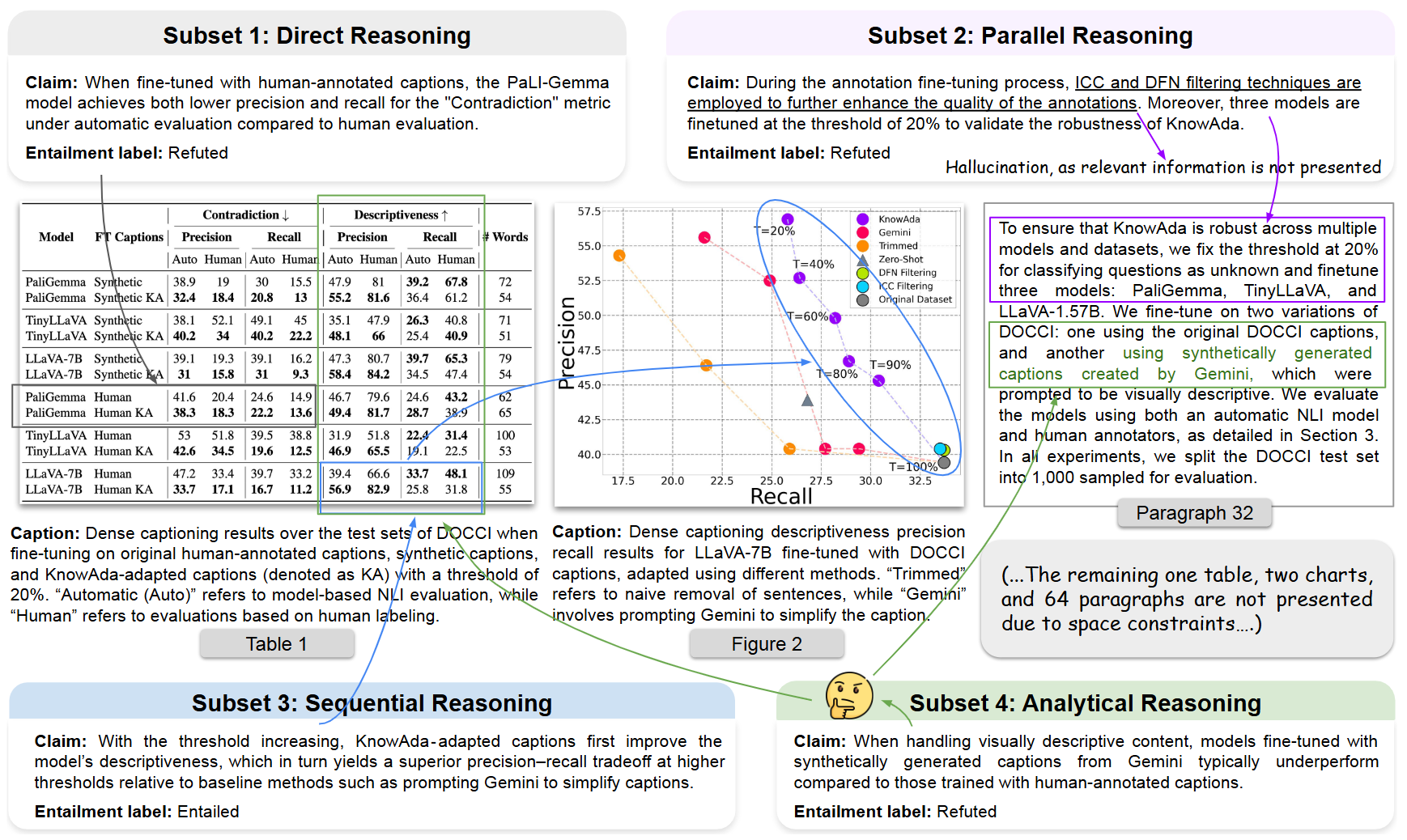Datasets:
annotations_creators:
- expert-generated
language:
- en
license: cc-by-4.0
multilinguality: monolingual
size_categories:
- 1K<n<10K
source_datasets:
- original
task_categories:
- text-classification
- image-text-to-text
task_ids:
- fact-checking
pretty_name: SciVer
SCIVER: A Benchmark for Multimodal Scientific Claim Verification
📰 News
- [May 15, 2025] SciVer has been accepted by ACL 2025 Main!
👋 Overview
SCIVER is the first benchmark specifically designed to evaluate the ability of foundation models to verify scientific claims across text, charts, and tables. It challenges models to reason over complex, multimodal contexts with fine-grained entailment labels and expert-annotated rationales.
📌 “Can Multimodal Foundation Models Reason Over Scientific Claims with Text, Tables, and Charts?”
🌟 Highlights
- 🧪 3,000 expert-annotated examples from 1113 scientific papers
- 🧠 Four core reasoning subsets:
- Direct
- Parallel
- Sequential
- Analytical
- 📚 Context includes text paragraphs, multiple tables, and charts
- 🔍 Labels:
Entailed,Refuted - 📈 Evaluated across 21 leading foundation models, including o4-mini, GPT-4o, Gemini, Claude 3.5, Qwen2.5-VL, LLaMA-3.2-Vision, etc.
- ⚖️ Includes step-by-step rationale and automated accuracy evaluation
🧩 Benchmark Structure
Each SCIVER sample includes:
- A claim grounded in multimodal scientific context
- Contextual inputs: text, tables (as images), charts (as images)
- A gold entailment label (entailed / refuted)
- Supporting evidence and a reasoning rationale
🧠 Subsets by Reasoning Type
- Direct Reasoning – extract simple facts
- Parallel Reasoning – synthesize info from multiple sources
- Sequential Reasoning – synthesize info from multiple sources
- Sequential Reasoning – perform step-by-step inference
- Analytical Reasoning – apply domain expertise and logic
📊 Model Evaluation
We evaluate 21 models using Chain-of-Thought prompting.
| Model | Accuracy |
|---|---|
| 🧑🔬Human Expert | 93.8% |
| o4-mini (OpenAI) | 77.7% |
| GPT-4o | 70.9% |
| Qwen2.5-VL-72B | 69.4% |
| InternVL3-38B | 62.5% |
Text-only versions of models drop 35–53% in accuracy — showing multimodal context is essential.
🛠️ Quickstart
🔁 Step 0: Installation
git clone https://github.com/QDRhhhh/SciVer.git
cd SciVer
conda create --name sciver python=3.10
conda activate sciver
pip install -r requirements.txt
🔁 Step 1: Download Dataset from huggingface
git lfs install
git clone https://huggingface.co/datasets/chengyewang/SciVer
🔁 Step 2: Run Model Inference
bash scripts/vllm_large.sh
This will generate model responses and save them to:
./outputs/
✅ Step 3: Evaluate Model Accuracy
python acc_evaluation.py
The processed results and accuracy scores will be saved to:
./processed_outputs/
🤝 Contributing
We welcome contributions for:
- 🧬 Domain extension (e.g., biology, medicine)
- 🔧 Additional model adapters
- 📈 New evaluation metrics and visualization tools
✍️ Citation
If you use our work and are inspired by our work, please consider cite us:
@misc{wang2025sciver,
title={SciVer: Evaluating Foundation Models for Multimodal Scientific Claim Verification},
author={Chengye Wang and Yifei Shen and Zexi Kuang and Arman Cohan and Yilun Zhao},
year={2025},
eprint={2506.15569},
archivePrefix={arXiv},
primaryClass={cs.CL},
url={https://arxiv.org/abs/2506.15569},
}
